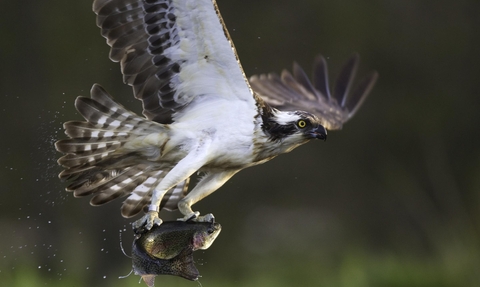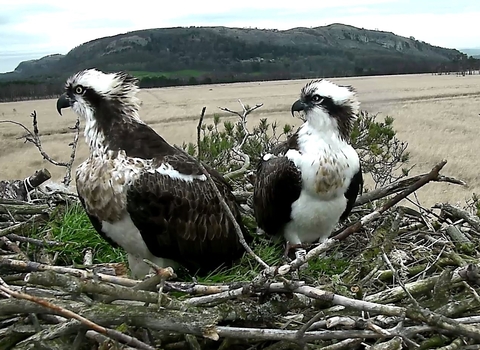
Osprey (pandion haliaetus) fishing, Cairngorms National Park, Scotland © Peter Cairns/2020Vision
Osprey - bird of prey
Osprey bird of prey, scientific name: Pandion haliaetus
The osprey is a spring
A great way to get up close and personal to an osprey is via our osprey webcam at our Foulshaw Moss Nature Reserve.
Ospreys at Foulshaw Moss Nature Reserve in Cumbria
Our conservation work to restore Foulshaw Moss Nature Reserve has encouraged ospreys to visit since the late 1990s. Improvements to the habitat and the installation of a number of nesting platforms now provides the ideal location for ospreys to nest and to breed, and for many other species too.
In 2014, for the first time, a pair of osprey successfully bred and reared three healthy chicks at the reserve and have been returning to breed here. The male, White YW, hatched in 2008 at Bassenthwaite and the female, Blue 35, hatched in 2010 at Kielder.
Do ospreys mate for life?
Ospreys are faithful to their nest site and to their mate. They very rarely leave a living partner but, if their mate fails to return from migration, they will often find another partner to make sure that they have the opportunity to pass their genes on to a further generation.
What is the typical lifespan of an osprey?
Ospreys have a typical lifespan of 9 years and can live up to 20 or 25 years.
What do ospreys eat?
Ospreys eat fish, hunting for them in lakes and lochs, stretching out their talons and scooping their catch out of the water. Foulshaw Moss Nature Reserve is next to the Kent Estuary as well as near the rivers, lakes and tarns, giving the birds various fishing places.
How to identify an osprey
The osprey is a brown-and-white bird which could possibly be mistaken for a seagull at a distance. The osprey is a large bird of prey with dark brown upperparts and contrasting white underparts that can appear mottled in females.
Their heads are white with a dark brown through their eyes. Their wings during flight show strong barring and distinctively dark brown, angled ‘wrists’.
Where do ospreys nest in the UK?
Ospreys nest in parts of Scotland, Cumbria, the East Midlands and Wales. Ospreys can also be spotted at large waterbodies across the country during migration.
What type of habitat do ospreys need?
Where do ospreys migrate to in winter?
Ospreys migrate to West Africa and Portugal during winter; satellite tracking has shown them flying up to 430 km in just one day. It takes them about 20 flying days to complete the journey, but, in autumn, birds stop off to refuel at lakes and reservoirs.
Statistics
Length: 56cm
Wingspan: 1.6m
Weight: 1.5kg
Average lifespan: 9 years
Conservation Status
The osprey is classified in the UK as Amber under the Birds of Conservation Concern 5: the Red List for Birds (2021). Protected in the UK under the Wildlife and Countryside Act, 1981.

Osprey nest
Watch the osprey family, in their nest and roost tree, at Foulshaw Moss Nature Reserve. They're usually here between March to early September.







